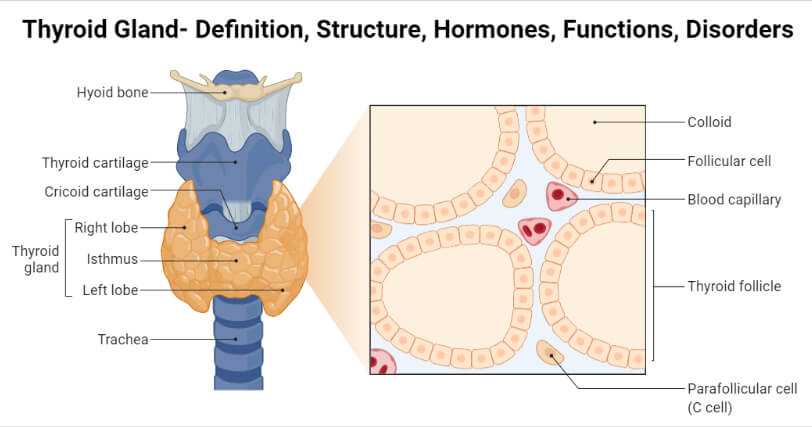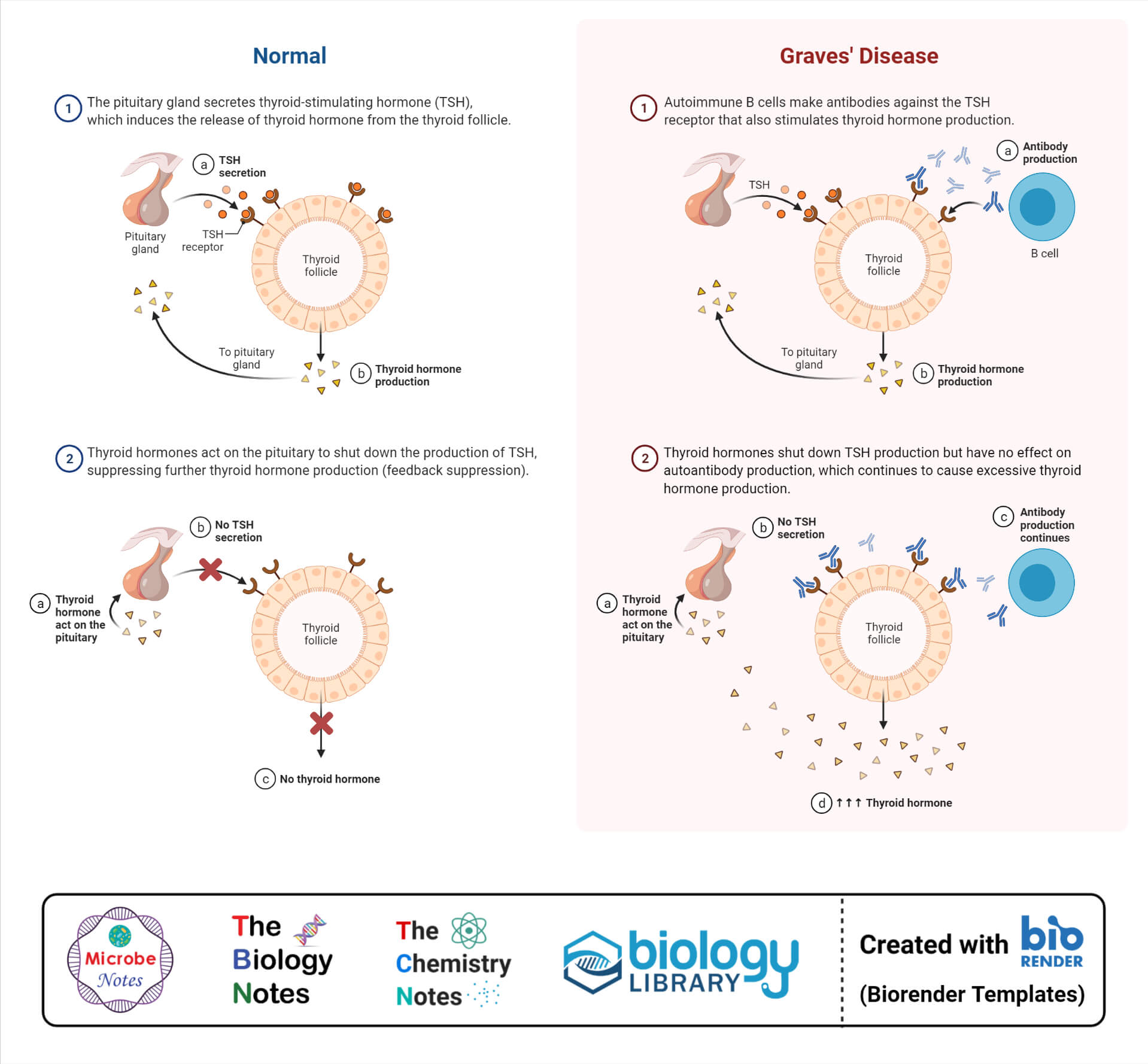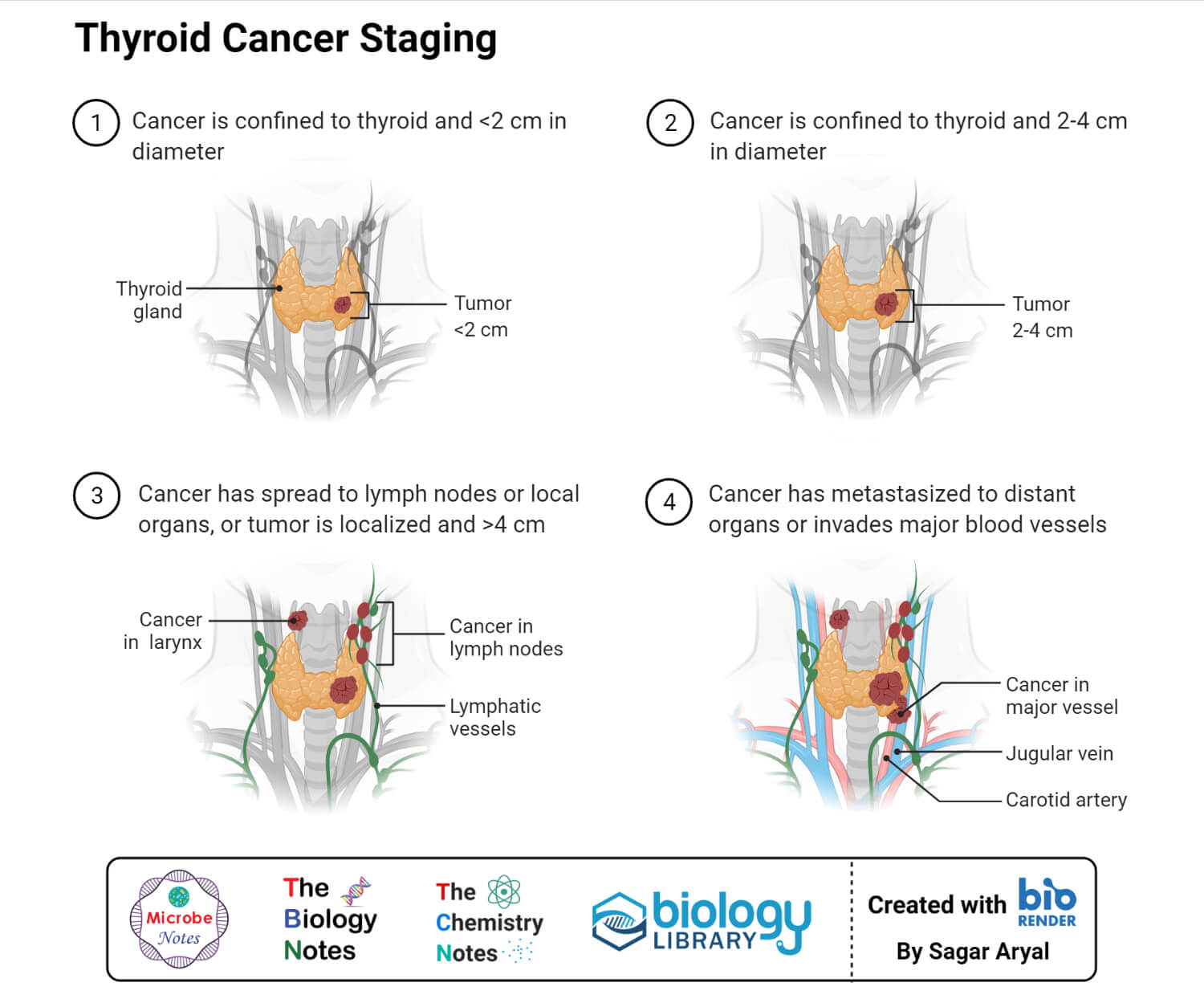Interesting Science Videos
What is Thyroid Gland?
Thyroid Gland Definition
The thyroid gland is an endocrine gland that occurs in the neck and is essential for iodine metabolism and secretion of thyroid hormones.
- The gland is small and highly vascular, like most endocrine glands. It occurs in the neck between the 5th, 6th, and 7th cervical vertebrae.
- The development of the gland and secretion of thyroid hormones is regulated by the anterior pituitary, which in turn is regulated by the hypothalamus.
- The thyroid gland is the largest pure endocrine gland in the body. Since the gland is large and highly vascular, thyroid surgeries are usually difficult.
- Embryologically, thyroid glands develop by the pharynx at the third or fourth week of pregnancy. The gland then slowly moves down and migrates to the base of the neck.
- The thyroid gland secretes two important hormones that are composed of iodine atoms; triiodothyronine and thyroxine. Besides, the thyroid gland also secretes a peptide hormone called calcitonin.
- Thyroxine and triiodothyronine are involved in the regulation of fat metabolism as well as growth and development in children.
- The hormone calcitonin plays an essential role in calcium metabolism and homeostasis.
- The gland rests on the thyroid cartilage and has two lobes on either side of the cartilage. The two lobes of the gland are joined together by a narrow piece of muscle called the isthmus.

Structure of Thyroid Gland
- The thyroid gland is a butterfly-shaped gland that is present on the anterior side of the neck, in front of the trachea.
- The gland weighs about 25 grams and has two lobes on either side of the trachea. Each of the lobes is cone-shaped, 5 cm long, and 3 cm wide.
- In between the two lobes is a median mass of tissue called the isthmus, which connects the two lobes.
- The internal structure of the gland consists of hollow spherical follicles that remain scattered through the structure.
- The walls of these follicles are composed of cuboidal epithelial cells, also known as follicular cells.
- These cells secrete the thyroid hormones in the form of a glycoprotein called thyroglobulin. The hormone is released in the form of an amber-colored, sticky liquid called colloid.
- In addition to the follicular cells, the thyroid gland also contains parafollicular cells, which produce calcitonin.
- The parafollicular cells are present within the follicular epithelium and do not form a separate mass with the connective tissue.
- The thyroid gland is highly vascular and is supplied with arterial blood supply through the superior and inferior thyroid arteries.
Hormones of Thyroid Gland
The thyroid gland secretes three different hormones; triiodothyronine, thyroxine, and calcitonin.
1. Thyroid Hormone (thyroxine and triiodothyronine)
- Thyroid hormone consists of two iodine-containing hormones, thyroxine and triiodothyronine.
- Thyroxine is also known as T4 as it contains four atoms of iodine, whereas triiodothyronine is also called T3 as it contains three atoms of iodine.
- The follicular cells of the thyroid gland produce thyroxine as the major hormone, which is then converted to T3.
- Both thyroxine and triiodothyronine are composed of two tyrosine amino acid units linked together with iodine atoms. The number of iodine atoms differs between the two hormones.
- The primary function or role of thyroid hormone is to increase the basal metabolic rate and heat production via glucose oxidation.
- Besides, it is also necessary for tissue growth and development, especially in the case of skeletal and nerve tissues.
- The level of thyroid hormone in the blood is regulated by the pituitary gland by the release of thyroid-stimulating hormone. The regulation and control of the release of thyroid hormone work by a negative feedback mechanism.
2. Calcitonin
- Calcitonin is secreted by the parafollicular cells or C cells of the thyroid gland as a response to an increased level of calcium in the blood.
- However, the hormone is not given as much importance as the increased level of calcium in the blood doesn’t have a physiological effect on the body.
- Calcitonin is given to patients suffering from osteoporosis as it has a bone-sparing effect.
- Calcitonin acts on bones where it inhibits osteoclastic activity, decreasing the release of calcium into the blood. It also stimulates the uptake of calcium from the blood into the bone matrix.
Thyroid Gland Video Lecture by Dr. Frank O’Neill

Functions of Thyroid Gland
The following are some of the functions of the thyroid gland:
- The most important function of the thyroid gland is to produce thyroid hormones that are essential for metabolic activities and growth.
- The thyroid hormone regulates the basal metabolic rate in the body by influencing glucose, fat, and protein metabolism.
- The hormones are composed of iodine atoms; thus, these also play an essential role in iodine metabolism in the body.
- Calcitonin produced by the C cells of the thyroid gland regulates the levels of calcium ions in the blood.
- The thyroid hormone plays a crucial role in the growth and development of the target organs in the body like the brain and kidneys.
Diseases and Disorders of Thyroid Gland
The disorders and diseases associated with the thyroid gland are usually due to the hypersecretion or hyposecretion of the hormones. The following are some of the disorders associated with the thyroid gland and its secretions;
1. Grave’s disease

- Grave’s disease or Grave’s thyroiditis is a condition caused due to the hypersecretion of the thyroid hormone.
- The condition is more common in women than in men and can occur at any age but is common among individuals between 30-50 years.
- Grave’s disease is an autoimmune condition in which the abnormal antibodies of the body are directed against the thyroid follicular cells.
- These unusual antibodies mimic the thyroid-stimulating hormone of the pituitary gland and stimulate the thyroid gland to produce the hormone.
- Some of the common symptoms associated with this condition are nervousness, elevated metabolism, sweating, weight loss, etc.
2. Simple goiter
- Simple goiter is a condition caused by the hyposecretion of the thyroid hormone as a result of enlargement of the gland.
- Goiter is characterized by the formation of extra thyroid tissue, which causes the enlargement of the gland.
- It is caused due to persistent iodine deficiency, which causes a relative lack of T3 and T4 in the body.
- In some cases, the increased size of the gland can cause damage to the adjacent tissues like the esophagus and nerves.
3. Cretinism
- Cretinism is caused due to the hyposecretion of thyroid hormone in children.
- Clinical features of the condition are observed in the form of mental retardedness and a disproportionately sized body.
- The effect of the condition depends on the age and physiological activity of the individual, but it is usually more severe in children than in adults.
- Cretinism might be caused due to genetic deficiency of the thyroid gland or maternal factors like the lack of iodine.
4. Thyroid tumor
- Malignant tumors of the thyroid gland are rare, but benign tumors, including single adenomas, are fairly common.
- However, in the case of older adults, the tumor might become malignant.
- Even with benign tumors, some might produce a large amount of hormones, resulting in hyperthyroidism.

References
- Hall JE and Guyton AC. (2011) Textbook of Medical Physiology. Twelfth Edition. Elsevier Saunders.
- Waugh A and Grant A. (2004) Anatomy and Physiology. Ninth Edition. Churchill Livingstone.
- Marieb EN and Hoehn K. (2013) Human Anatomy and Physiology. Ninth Edition. Pearson Education, Inc.
- Rastogi SC. (2007) Essentials of Human Physiology. Fourth Edition. New Age International Limited.
- InformedHealth.org [Internet]. Cologne, Germany: Institute for Quality and Efficiency in Health Care (IQWiG); 2006-. How does the thyroid gland work? 2010 Nov 17 [Updated 2018 Apr 19]. Available from: https://www.ncbi.nlm.nih.gov/books/NBK279388/
